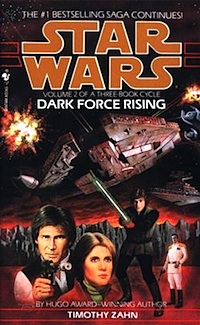Sometimes our memory of cultural classics doesn’t always match up with the experience of the real thing. (Though many of us believe KISS’s one and only song is “Rock and Roll All Night,” it turns out their albums are somehow actually full of other songs.) Sadly, upon revisiting Dark Force Rising, the second book in Timothy Zahn’s “Thrawn Trilogy,” we discover it’s actually a book in which not much happened; a get-from-point-A-to-point-B tale sadly sandwiched between two, slightly better, more interesting volumes.
Make no mistake, I’ll still take a movie version of Dark Force Rising over Attack of the Clones, but the title of this book might betray its inherent problem. Like watching a soufflé bake in the oven, we’re literally just watching the story rising, very, very slowly. While none of the three entries in Zahn’s trilogy could be accused of being “action packed,” this one is the least so, and sadly the least memorable. Within the real Star Wars trilogy, The Empire Strikes Back is the point when everything gets crazy, the heroes are tested, and you’re really, really worried by the end. But trilogies of novels are not necessarily like trilogies of films, and, by and large, what happens in Dark Force Rising is this: the characters and spaceships move around a little bit.
In a sense, it’s best to take the Thrawn Trilogy as a whole story, and not worry too much about the individual strengths and weaknesses of each book. The easiest comparison here is the middle volume in The Lord of the Rings trilogy; The Two Towers. When translated into films, Peter Jackson had the good sense to restructure events from different books and insert those events in an order that made the most sense for maximum excitement, which is not what the book does. Dark Force Rising, however, has not been translated into a film, and as such contains similar problems of Tolkien’s Two Towers. Is this the fault of Zahn? Well, technically, yes, but really, I feel like this middle book is more a victim of the first novel’s success. In Heir to the Empire, Timothy Zahn managed to present the Star Wars universe as a more realistic, navigable science fiction world, complete with logistics and rules not only for the large amount of spacecraft, but also the Force itself.
The problem then comes that Zahn has to adhere to his rules, which makes things seem to move a little slow. What is this Dark Force that is Rising? Well, initially it concerns Thrawn’s attempts to get a hold of a massive fleet of Dreadnought ships known as the Katana fleet. Essentially, this mess is a lost group of ships that function on a remote-control-type system which, if acquired by Thrawn, will give him a massive tactical advantage in taking on The New Republic. Basically, between trying to grow a clone army, and having ships that used to operate on remote-control, Thrawn is pulling a cheap Palpatine-esque move in terms of making a grab for power. (You’ve really got to wonder how these bad guys feel about needing to literally grow batches of soldiers who will take orders from them.) However, a good portion of Dark Force Rising merely deals with trying to figure out who knows about the Katana Fleet, why they know about it, and what they’re going to do when they find it.
Han and Lando try and wrangle in a guy named Garm Bel Iblis (no relation to Count Iblis from classic Battlestar Galactica, but oh boy was I confused by that as a child) who was supposedly one of the original leaders in the Rebellion against the Empire. Garm isn’t too hot to play ball with The New Republic, because he doesn’t like Mon Mothma. Meanwhile, back in space politics land, Borsk Fey’lya may or may not be a traitor, but luckily, is still very, very furry.
Wait! Massive fleet movements, with ships controlled by remote, and also clone troopers being created? This sounds all very familiar…did George Lucas just re-order elements from the Zahn trilogy for the prequels? Or maybe this is a contemporary Battelstar Galatica thing: “this has all happened before and will all happen again.” In any case, space politics and secret plotting are at the core of Dark Force Rising and so much so that it’s hard not to see the similarities thematically and superficially between it and the prequel films, specifically Attack of the Clones. Thankfully Lando and Han don’t go to a space diner and hang out with some four-armed weirdo while sipping on space milkshakes.
Dark Force Rising is the Attack of the Clones of this trilogy, but only insofar as it’s simply a story that sets up things which need to be resolved in the next part of the story. It’s much better than Attack of the Clones, but mostly that’s because it contains the same awesome characters from the first book. There’s no denying how interesting this plot was back in 1992, but now, over 20 years later, Star Wars has become almost exclusively known for space politics and clone armies. Back then, this was a smart innovation, and a thematic revelation. Now, sadly, it reads like a distraction from the cool character stuff we’re really interested in.
Luke and Mara’s story gets a little bit of traction here, but it doesn’t become truly awesome until the next book. The title “Star Wars” might make us think everyone loves all the space battles, but the real thing that makes Star Wars tick is its people. Unfortunately Dark Force Rising subdues some of those characters in favor of space politics, and empty ships being run on remote control by a guy we’re not too crazy about.
Ryan Britt is a staff writer for Tor.com.










